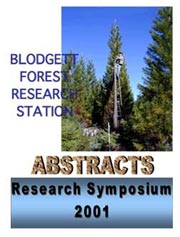 |
||||||||||||||
|
||||||||||||||
| 2001 Blodgett Forest Research Symposium |
| Research Projects | Research Publications | Back to TABLE OF CONTENTS |
|
|||||
Forest rhizosphere respiration releases a significant portion of the terrestrial carbon to the atmosphere. However, direct quantification of forest rhizosphere respiration has been technically challenging. To face this challenge, a research project has been initiated at a Sierra pine site near the Blodgett Forest Station. One of the objectives of this project was to assess rhizosphere respiration in the forest using a natural 13C tracer method. In this experiment, a C4-derived soil from Konza Tallgrass prairie was "transplanted" into four soil pits in the forest. Each pit was positioned at the drip line of a mature ponderosa pine tree. Carbon dioxide samples from soil air were collected at the center of each Konza soil pit and nearby in native soils, and analyzed for 13C natural abundance. Surprisingly, the d13C values were similar for both C3 (-22.6‰) and transplanted C4 Konza (-21.9‰) soil pits, indicating the disappearance of the expected _13C difference due to some unknown causes. Minirhizotron tubes were also installed in both native (6 tubes per replication) and Konza (2 per replication) soil plots. Digital images of the upper soil-tube interface were taken monthly starting in April 2000. Data from these minirhizotron images are forthcoming. A MINI-REPORT: In forest ecosystems, plant respiration may account for 50% of the primary production. A major portion of this respiration occurs in the roots. Carbon dioxide respired by a system of living roots and soil has two sources: (1) rhizosphere respiration (RR) including root respiration and rhizo-microbial respiration utilizing carbon from live roots, and (2) microbial respiration using carbon from soil and detritus. According to rough estimates, RR may contribute up to 90% of the CO2 released from belowground components in forest ecosystems. Therefore, RR is one of the most important belowground processes responsible for carbon release. Direct measurements of RR have been rare, mostly due to difficulties involved in separating RR from total soil respiration in field conditions. Labeling with carbon isotopes has unsolvable problems for forest ecosystems. The most difficult limitation of all is to uniformly label large trees in a forest due to the high cost, long time required, and other logistical considerations. It is not surprising that these labeling approaches have rarely been used in true forest conditions. To circumvent these problems, a natural 13C tracer approach was tried in a research project (funded by NSF) initiated at a site near the Blodgett Forest Station in the fall of 1999. The principle of this natural 13C tracer method is based on the difference in 13C:12C ratio between plants with the C3 photosynthetic pathway and plants with the C4 pathway, and on the subsequent difference in 13C isotopic composition between soil C derived from the two types of plants. By using a C4-derived soil in a C3 plant-dominated system such as a forest, the carbon entering the soil via roots will have a different 13C signature than the 13C signature of the soil. Thereby RR can be separated from the total soil CO2 efflux by monitoring the 13C signature of the respired C. In this experiment, a C4-derived soil from Konza Tallgrass prairie near the long-term ecological research site was "transplanted" into four soil pits in a mixed Sierra Nevada conifer stand. Pit dimensions were approximately 75 X 75 X 45L cm (W, L, D), and each pit was positioned at the drip line of a mature ponderosa pine tree. The excavations were performed such that roots were retained in the pits. Photographs of each pit made prior to filling them with the Konza soil permitted root quantification, including estimates of root dimensions, volume, surface area, and mass. In August 2000, soil CO2 gas samples were collected near the center of each Konza soil pit and nearby in native soils. The d13C values were similar for both C3 (-22.6‰) and transplanted C4 Konza (-21.9‰) soil pits, indicating the disappearance of the expected difference. The exact causes of these results are unknown at the present time. Minirhizotron tube were also installed in both native (6 tubes per replication) and Konza (2 per replication) soil plots. Digital images of the upper soil-tube interface were taken monthly starting in April 2000. Example root images were posted at: http://www2.ucsc.edu/people/rbs/mrt/. As part of the project, soil temperature, moisture, surface CO2 effluxes, root biomass from soil cores, and mycorrhization have been measured both in the native plots and in the Konza soil plots. |
|||||
Contact Author: Weixin Cheng, Environmental Studies Department, Natural Sciences 2, University of California, Santa Cruz, 1156 High Street, Santa Cruz, CA 95064, (831) 459-3791 Richard Susfalk: Environmental Studies,UC Santa Cruz Dale Johnson and Roger Walker: ERS, University of Nevada-Reno Paul Verburg and David Schorran: Desert Research Institute, Reno |
|||||
|
|||||
|
University of California Center for Forestry, UC Berkeley. Last modified: 6/27/02 ©Copyright, 2001. The Regents of the University of California. For questions and comments, contact webmaster. |
